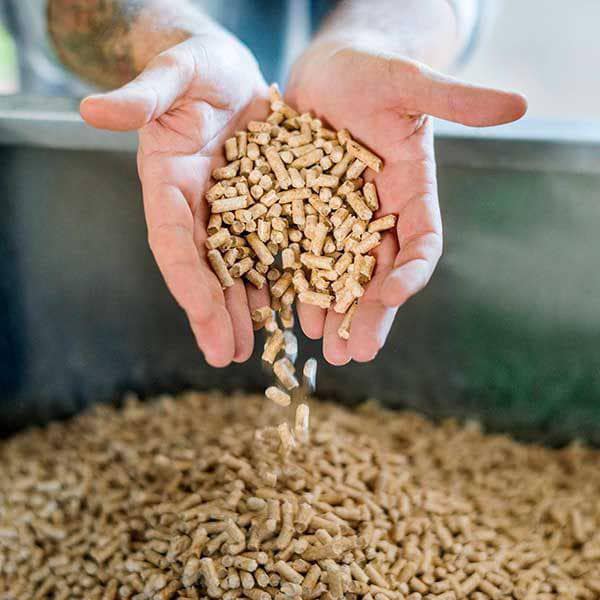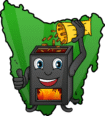Pellet heaters are, and yes I run a pellet heater website so I am clearly biased, a great way to stay warm. Real heat, real fast, without the hassle. However, the quality of the wood pellets used can greatly impact on how well your pellet heater runs and heats your house. Poor quality pellets can cause issues such as excessive ash and clinkers, which can lead to reduced heater efficiency and more maintenance and cleaning. I touched on the importance of wood pellet length in another article, but below I’ll dive a little deeper and talk about other ways you can check the quality of pellets before you buy them.

Want to make sure you get the best quality pellets you can? Here’s some tips on how to check wood pellet quality. Read on below for more info:
- Length test – uniform pellet length 2cm to 4cm
- Smell test – wood pellets should smell natural
- Visual inspection – light brown vs dark brown pellets
- Smoke test – pellets should smell like wood when lit
- Water test – high quality pellets dissolve quickly in water
- Density test – wood pellets should have uniform density
Length Test
Ideally, you want wood pellets to be around 2cm to 4cm in length. In reality you will probably see pellets that are 1cm to 4cm. Wood pellet length is important because it affects how many pellets are fed into the burn pot and the heat output. The more uniform or consist the length of pellets, then the more even burn you’ll get and constant heat output from your pellet heater. As I’ve mentioned elsewhere on my wood pellet length article, just eyeball a bag of pellets. Do the pellets look about the same length? Are there any really short or really long pellets?
If the pellets are all very long or all very short, then you’ll find that your pellet heater may not burn correctly. Short pellets will mean more pellets, meaning a bigger fire and more heat output. It’ll also mean you’ll burn through a bag of pellets faster. Longer pellets do the opposite. They are fed slower into the burn pot, creating a smaller fire and less heat out. So you won’t be getting the same kind of heat from a bag of pellets that are all very long. When you go to buy wood pellets just quickly look the bags over. You’ll be able to see very quickly if the pellets look uniform or length or are too short or too long.
Smell Test
The next thing you can do to try and make sure you get good quality pellets is the “smell test”. This is an interesting one and I personally don’t know how accurate this is but some websites claim high-quality pellets should smell like freshly cut softwood. What I think they mean here is that pellets should NOT smell like anything other than wood. If the pellets have an unpleasant or strange smell (as in they don’t smell like wood), it could be a sign that something is wrong.
The mill may have had to use binding agents to bind the pellets or the raw wood material they used could be poor quality, such as coming from wooden pallets. Also, if the pellets were stored incorrectly, like outside in the rain, then a damp or moldy smell might be a sign the pellets weren’t stored properly and won’t burn very well. Again, I don’t think you’ll get a “freshly cut wood” smell when you open a bag of pellets and take a sniff but instead check to see if the pellets have a natural smell or not. If they don’t smell natural, then it may be an indication that the material used to make the pellets was poor quality.
Visual Inspection
In addition to the smell test, the visual inspection of wood pellets is another good way to test their quality. The colour of the pellets can reveal a lot about their quality. High-quality pellets should be light brown in colour since they are made from clean waste material. However, if the pellets are darker in color, it could be a sign of bark content, which increases the amount of ash and can lead to clinkers. Clinkers are a natural part of owning a pellet heater but low quality pellets form clinkers more often, which means the burn pots needs to be cleaned frequently to keep the fire burning efficiently.
Furthermore, it is important to pay attention to the outer layer of the pellets. While the outer layer of pellets may be darker due to friction in the pressing dies, this is not an issue as long as the pellets are light in color inside. Breaking a pellet in half can reveal the colour on the inside. If the inside is darker in colour, it is a sign that the pellets may have a high bark content and are of lower quality. Paying attention to the color and texture of the pellets can provide valuable insight into their quality.
Smoke Test
The smoke test is another way to test the quality of wood pellets. To perform the smoke test, simply take one longish pellet and light it at the tip. The smoke produced should smell like burning wood. If the smoke has an unusual smell or emits a large amount of smoke, it can be a sign of poor quality pellets. A smoky smell could indicate that the pellets contain additives, such as glue or other chemicals. Moreover, excess smoke can result in increased emissions, which are harmful to the environment and can pose health risks. Therefore, it is essential to ensure that the pellets produce a clean and natural smoke when burned, indicating high quality and efficient fuel.
Water Test
The dissolving test is a simple way to test the quality of wood pellets. To perform this test, take a small handful of pellets and place them in a glass of water. The pellets should dissolve into sawdust within a few minutes. If they do not dissolve, it could be an indication of the use of binding agents or poor quality wood material. After the pellets have dissolved, swirl the glass and observe what settles in the middle of the bottom of the glass. The heaviest particles will settle there. If there is a large amount of heavy particles, it might increase the amount of ash and clinkers. High quality pellets should dissolve fairly quickly and consist of fine particles.
Density Test
The density test is another important way to test the quality of wood pellets. To perform this test, take a vessel larger than 1 litre and weigh it on a kitchen scale, noting the empty weight. Fill the container to the brim with wood pellets and weigh it again, noting the weight. Then, fill the container with water and weigh it again. Deduct the weight of the container from both measurements and divide the weight of the pellets by the weight of the water. The result should be between 0.6 and 0.7 kg/litre and preferably around 0.65 kg/litre.
This indicates that the pellets have been pressed at the right pressure, resulting in a suitable density for efficient heating. If the pellets have a density below 0.6 kg/litre, they are too soft and break easily, forming fines as a consequence. Pellets with a low density may lead to reduced heating output, increased emissions, and more clinkers. Therefore, it is essential to ensure that the pellets have the correct density for optimal heating results.
Bonus Tip: Ask the Retailer
OK, I threw this one in for free and it’s probably the best and easiest way to check wood pellet quality. In my opinion, a good wood pellet retailer should be able to tell you what to look for when buying pellets but also they should check quality of their own pellet stock. It’s in their interest to sell pellets of good quality to their customers, because an unhappy customer won’t give them repeat business. In Tasmania, Pellet Fires Tasmania do everything they can to make sure they are selling a quality product.
No matter where you live or what retailer you buy your pellets from, they should be checking their own stock and help you to understand what makes a pellet good quality. If you are yet to buy a pellet heater and finding all of the above overwhelming, don’t. Ask the retailer where you plan to buy your pellets from what they do to make sure the pellets they sell are good quality. Any good pellet retailer should be able to tell you what they do to make sure you get good pellets from them.
Summary of 5 Ways to Check Wood Pellet Quality
Now, while each of the tests above are definitely useful, I think the most important and useful (besides asking a retailer) is checking pellet length. The reason for this is because most of the other ways to test pellet quality requires opening bags of pellets or other tools. If I had to pick a second test it would be the visual test. Dark brown pellets can definitely mean you’ll get a dirtier burn. However, please keep in mind the best way to check pellet quality is to burn them. The above methods are not fool proof.
Lastly, in addition to wood pellet length, the other way to check pellet quality is price. Yes, I’m not joking. The more expensive wood pellets are the better quality they’ll usually be. This is why in Tasmania we have pellets ranging in price from $8.50 to $13 because they are of different quality. The lower quality pellets produce more ash and clinkers, which is why they cost $8.50. Pellets for $13 a bag burn very clean and have almost no clinkers. Regardless, the above should help you spot better quality pellets and give you a much better heating experience.
P.S: Pellet heater brand and type of heater, such as a hydronic pellet boiler which heats water instead of air, does not change the importance of wood pellet quality. I see on many forums and FaceBook groups people boasting that their expensive pellet heater can burn any type of pellet, regardless of quality. Spending more money on a pellet heater does NOT mean it can somehow magically burn poor quality pellets better. All pellet heater brands, from expensive European Piazzetta pellet heaters to the cheaper Chinese pellet heaters, which are popular in Tasmania, are all impacted the same way by pellet quality.
Resources:
Simple ways to check wood pellet quality website
